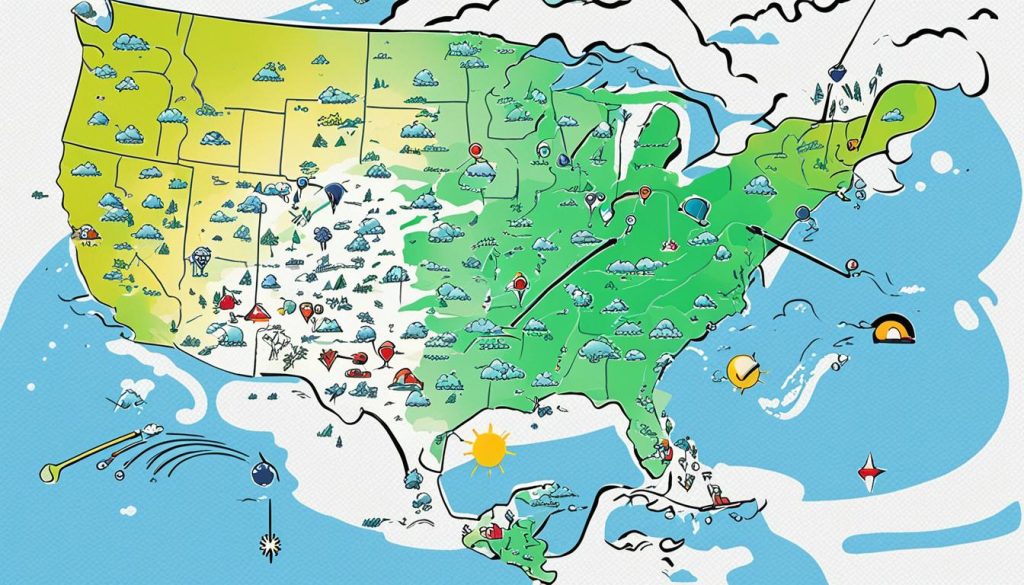Welcome to my guide on understanding weather patterns and forecast tips! As someone who is fascinated by the ever-changing climate and the art of meteorology, I’m excited to share some valuable insights that will help you navigate the often unpredictable nature of weather. Whether you’re planning outdoor activities, preparing for your daily commute, or simply curious about the latest forecast, this article will equip you with the knowledge and tools to stay one step ahead.
Key Takeaways:
- Understanding weather patterns is essential for interpreting forecasts.
- Radar plays a crucial role in tracking storms and predicting precipitation patterns.
- Staying updated with weather news and reports is vital for preparedness.
- Climate and temperature greatly influence weather conditions.
- Utilize forecast tools and resources to plan your activities effectively.
Exploring Weather Patterns
In this section, I will dive deeper into the fascinating world of weather patterns and their significant connection to climate. Understanding the science behind meteorology allows us to make more informed predictions about future weather conditions and be better prepared for upcoming changes.
Weather patterns are the repetitive variations in atmospheric conditions that occur within a specific region over a certain period. These patterns can range from daily fluctuations to long-term climate trends. By studying weather patterns, scientists can identify recurring trends and phenomena, providing valuable insights into future weather expectations.
“Weather patterns shape the fabric of our daily lives, influencing everything from what we wear to our outdoor activities. By understanding these patterns, we can anticipate potential weather changes and plan accordingly.”
Climate, on the other hand, refers to the long-term average of weather patterns observed over a specific period within a particular region. It encompasses factors like temperature, humidity, wind patterns, and precipitation. Climate provides a broader perspective and understanding of the prevailing weather conditions in a given geographic area.
Meteorology, the scientific study of the atmosphere, plays a crucial role in comprehending weather patterns and their relationship to climate. Meteorologists utilize various instruments, technologies, and data analysis techniques to collect and interpret weather data. By monitoring and analyzing weather patterns, meteorologists can develop accurate forecasts and provide valuable insights for individuals, industries, and governments.

Recognizing the factors that contribute to weather patterns is essential for interpreting forecasts effectively. These factors include air pressure systems, global wind patterns, ocean currents, and geographical features. For example, the distribution of land and water influences the formation of temperature and precipitation gradients, creating distinct weather patterns in different regions.
Weather patterns can vary significantly from one area to another. For instance, coastal regions might experience sea breezes and fog due to their proximity to large bodies of water, while inland areas may be characterized by dry and hot conditions. By understanding these unique regional patterns, we can anticipate the weather conditions specific to a given location.
As we delve deeper into the world of weather patterns and their connection to climate, we will explore specific examples and case studies that highlight the impact of meteorology on our daily lives. By increasing our understanding of weather patterns, we can make more informed decisions, be better prepared for weather changes, and enjoy a safer and more enjoyable outdoor experience.
Navigating Forecast Tools
When it comes to planning your day or preparing for upcoming weather events, having access to accurate and timely information is crucial. In this section, we will discuss essential tools that will help you navigate weather forecasts with confidence. From understanding the significance of radar in predicting precipitation patterns to staying updated with the latest weather updates, we’ve got you covered.
The Importance of Radar
Radar plays a pivotal role in understanding weather conditions. By utilizing radar technology, meteorologists can track storm movements and identify potential areas of heavy rainfall or severe weather. It allows them to visualize the intensity and direction of storms, giving you a better understanding of what to expect in your area.
By incorporating radar data into weather forecasts, forecasters can provide more accurate predictions, ensuring you have the necessary information to make informed decisions. Whether you’re planning a weekend getaway or preparing for a significant weather event, radar insights can help you stay one step ahead.
Staying Updated with Weather Information
Obtaining reliable and up-to-date weather information is vital for effective planning. With the abundance of weather apps, websites, and TV channels available, it can sometimes be overwhelming to choose the right source.
One way to streamline your weather updates is by subscribing to reputable weather websites or downloading dedicated weather apps. These platforms offer real-time information, including temperature, precipitation chances, and severe weather alerts. By customizing your preferences, you can receive notifications tailored to your location and specific weather interests. This way, you’ll always be informed about significant weather changes.

Another great way to stay updated is by following trusted meteorologists and weather forecasters on social media platforms. Many experts share valuable insights and timely updates, keeping you informed about weather patterns and potential disruptions. Additionally, they often provide explanations and answer questions from their followers, adding a personal touch to the information you receive.
By combining radar technology with reliable weather updates, you can confidently plan your day, whether it’s scheduling outdoor activities, adjusting travel plans, or taking necessary precautions to stay safe during severe weather events.
Conclusion
In conclusion, our exploration of weather patterns and forecast tips has provided valuable insights into understanding and navigating daily climate changes. By utilizing the knowledge gained, you can confidently make informed decisions based on forecasted weather conditions.
Staying informed with weather news and weather reports is crucial for staying prepared. Regularly checking for updates will help you stay ahead of any changes in the weather. By considering the influence of climate and temperature, you can better anticipate fluctuations in weather patterns.
Remember, by making use of essential forecast tools such as radar and staying updated with the latest information, you can effectively plan your day and adapt to changing weather conditions. So, whether you’re getting ready for an outdoor event or planning your daily activities, keeping track of the forecast will ensure you’re prepared for whatever Mother Nature has in store.
FAQ
What is the difference between weather and climate?
Weather refers to the short-term atmospheric conditions in a specific location, such as temperature, humidity, precipitation, and wind. Climate, on the other hand, describes the long-term average weather patterns of a region over a period of time, usually 30 years or more.
How do meteorologists forecast the weather?
Meteorologists use a variety of tools and techniques to forecast the weather. These include analyzing weather observations, satellite imagery, radar data, computer models, and historical weather patterns. By combining these sources of information, meteorologists can make predictions about future weather conditions.
What is radar and how is it used in weather forecasting?
Radar, which stands for “Radio Detection and Ranging,” is a technology used to detect and track precipitation, such as rain, snow, and storms. Weather radar sends out pulses of radio waves that bounce off objects in the atmosphere and return to the radar, allowing meteorologists to monitor the movement and intensity of precipitation. This information is crucial for predicting and tracking storms.
How often are weather forecasts updated?
Weather forecasts are typically updated multiple times a day, depending on the specific forecast provider. Most weather websites, apps, and news stations provide regular updates, often at least once every few hours. However, during severe weather events or rapidly changing conditions, updates may occur more frequently.
How can I stay updated with the latest weather information?
There are several ways to stay updated with the latest weather information. You can check weather websites or apps, listen to local weather reports on the radio, watch the weather segment on television news, or even sign up for weather alerts through text messages or email notifications. Utilizing multiple sources can help ensure you have the most up-to-date and accurate information.
Why is it important to consider weather conditions when planning activities?
Weather conditions can greatly impact outdoor activities, travel plans, and overall safety. Understanding the forecasted weather allows you to make informed decisions about what to wear, whether to bring umbrellas or jackets, and if it is safe to engage in certain activities. It helps you prepare and adapt to changing weather conditions, ensuring a more enjoyable and secure experience.






